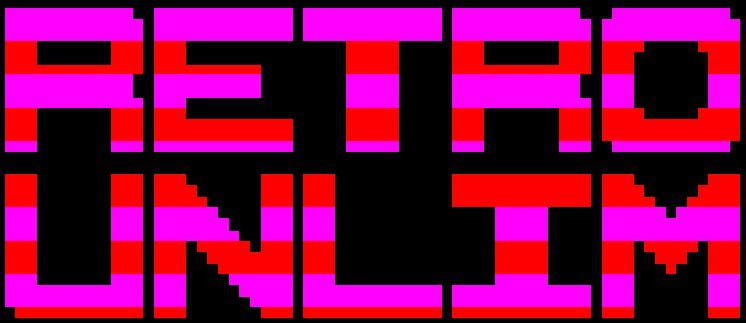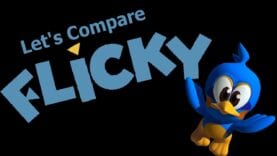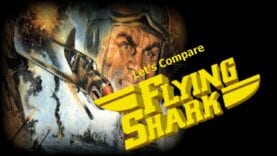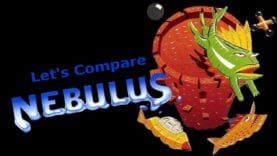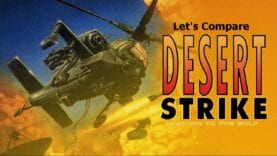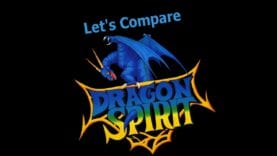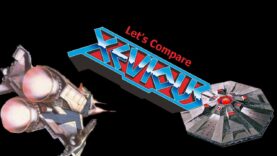Let’s Compare ( Xevious )
Gaming History Source
1. Arcade 1:02
2. Arcade ( Arrangement ) 3:40
3. Atari 2600 ( Prototype ) 6:39
4. Atari 2600 ( Home Brew) 8:07
5. Atari 5200 ( Unreleased Prototype ) 10:46
6. Atari 8-bit 13:25
7. Apple 2 16:10
8. Commodore 64 18:48
9. Samsung SPC-1000 21:28
10. ZX Spectrum 24:06
11. Amstrad 26:44
12. NEC PC 6000 29:22
13. Sharp MZ-700 32:01
14. Fujitsu FM-7 34:39
15. Sharp X1 37:18
16. NEC PC-8801 39:56
17. NEC PC-M8801 MkIISR 42:34
18. NEC PC-9801 45:13
19. Atari 7800 47:52
20. Nintendo Famicom Disk System 50:30
21. Nintendo Entertainment System 53:14
22. Gameboy Advance 55:52
23. MSX1 58:31
24. MSX2 Cinema ( 1:10:17 ) Gameplay ( 1:02:21 )
25. Atari ST 1:04:55
26. Fujitsu FM 77AV 1:07:34
27. Jakks Pacific ( Plug and play ) 1:10:27
28. PC Engine 1:13:16
29. Playstation Portable 1:15:33
30A. Sharp MZ-2500 8/16 color mode 1:18:47
30B. Sharp MZ-2500 4096 color mode 1:21:31
31. Platsyation 1:24:10
32. Nintendo DS 1:27:08
33. Sharp X68000 1:30:07
34. Windows ( Microsoft Revenge of arcade ) 1:32:46
35. Nintendo Wii 1:35:44
36. PS2 / Xbox / Gamecube 1:38:54
37. Flash 1:42:03
If you like this content. Please consider making a donation to the channel. It really helps me out.
Special Thanks to Top Retro Games for their help in locating the Sharp MZ-700 Version.
Please show thanks by visiting & subscribing to their channel.
https://www.youtube.com/@TopRetroGames
Thanks to b.p.s. for their help on the MSX version.
Please show thanks by visiting & subscribing to their channel.
https://www.youtube.com/@b.p.s.
Thanks to RETRO-ROCK for his help with the Nec Pc-8001MkIISR version. Please show Thanks by Visiting & subscribing to his channel.
https://www.youtube.com/@retro-rock3067
Thanks to Jr200Okada for his help with the FM-77AV Version.
Please show thanks by visiting & subscribing to his channel.
https://www.youtube.com/@jr200okada4
Description Source
https://strategywiki.org/wiki/Xevious
Xevious is an arcade game designed by Masanobu Endoh, one of Japan’s most respected game creators and the mastermind behind Namco’s later arcade hit of ’84, The Tower of Druaga. Xevious was one of the earliest vertical scrolling shootemups, and undoubtedly shaped the shoot ’em up genre that it helped to create. Following the wake of popularity of games like Space Invaders, Galaxian, and Galaga, Endoh desired to make a far more realistic game. Unlike those games, enemies do not sit passively in a formation or take kamikaze dives at your ship. Endoh did not think that a real enemy would behave so recklessly. Instead, they get as close as possible, take a good shot at you, and retreat to the top or the sides of the screen. It runs on three Zilog Z80 run at 3.072 MHz.
In addition to this realistic Artificial Intelligence, the game itself also ran on a kind of A.I. that adapted the challenges of the game to your performance. If you were clearing enemies rather quickly, Xevious ramped up the challenge by throwing a different type of enemy at you. If you played aggressively, Xevious responded more aggressively as well. This concept would be revisited several times, most notably by Compile’s Zanac, in 1986. Xevious had many other things going for it, including not one, but two forms of weapons, one for the air and one for the ground. Visually, it contained realistically shaded enemy characters, and an eyepopping scrolling background which went beyond what most arcade gamers had seen at the time. In addition to all of those, there were several secrets tucked away into the game for players to discover that kept them coming back to it, and a giant mothership that served as one of the earliest templates for a game boss.
Because of all this, Xevious was a massive hit in Japan. However, Xevious was only a modest success in the United States, where it was licensed and published by Atari. Divides in taste were never made more apparent than with Xevious, as Endoh had no problem designing a game whose challenge was ramped differently from one play experience to the next, and placing secrets randomly throughout the landscape, with very little indication to their whereabouts. Nevertheless, the game was ported to several consoles and computers. The Famicom version is a particularly celebrated early release for Japanese players.

